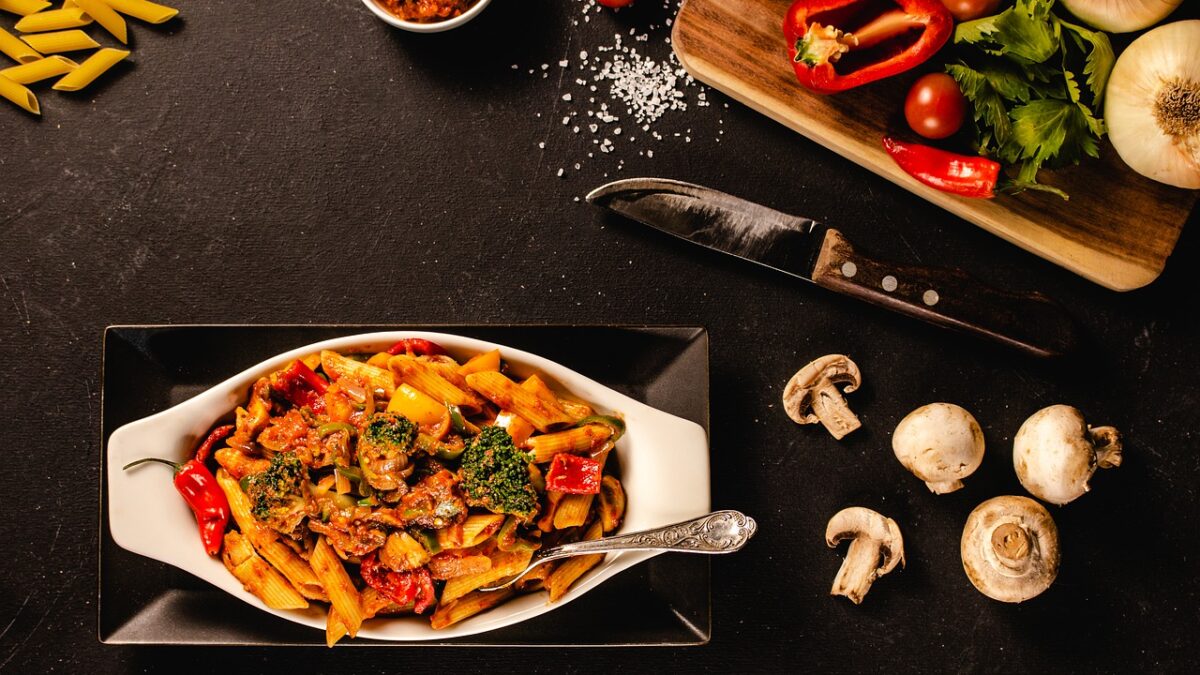Pasta primavera occupies a unique place in the world’s vast list of pasta recipes. The dish was invented in America relatively recently, in the 1970s. Its origins are a little hazy but it is believed to have first been served at the famous Le Cirque restaurant in New York. It was not an instant success, but over time (and thanks to a now-famous article that was published in the New York Times) it soon became a cult phenomenon.
At its core, pasta primavera is a combination of lightly cooked vegetables, pasta, and primavera pasta sauce. The type of pasta used is usually angel hair — a very long, skinny variation — however you can use any shape you want. Given the high vegetable content of the dish, it is quite a healthy and nutritious option, particularly for families. There are many different variations of the dish; here, we have presented both a classic iteration as well as one with a slight twist. Enjoy!
Classic Pasta Primavera
Serves 4.
Ingredients:
● 2 cups broccoli, broken into bite sized pieces
● 10 asparagus spears
● 1 cup green beans
● 1 cup frozen peas
● 2 cups sliced mushrooms
● 1 tbsp olive oil
● ½ tsp red pepper flakes
● 4 tbsp butter
● 2 tsp garlic, thinly sliced
● 4 tomatoes, diced
● 3 tbsp vegetable stock
● ¼ cup fresh basil, shredded
● ¼ cup fresh parsley, shredded
● 1 jar primavera pasta sauce
● ½ cup parmesan cheese
● 500 g spaghetti
Method:
1. Bring a large pot of water to the boil.
2. Add the asparagus spears and boil for 2 minutes.
3. Remove the asparagus spears and slice into bite sized pieces.
4. Add the broccoli to the boiling water and cook for 3 minutes.
5. Remove broccoli and leave to cool.
6. Add the green beans to the boiling water and cook for 3 minutes.
7. Remove green beans and leave to cool.
8. Bring a fresh pot of salted water to the boil.
9. Add the pasta and cook until al dente.
10. Meanwhile, add the oil to a large saucepan.
11. Add the mushrooms and sear over a high heat.
12. Once the mushrooms have absorbed most of their water, add the butter, red pepper flakes, garlic, and tomatoes.
13. Mix well to combine and cook for two minutes.
14. Add all the other vegetables — asparagus spears, broccoli, green beans, and peas.
15. Pour in the vegetable stock and bring to the boil.
16. Add the jar of primavera pasta sauce and mix well to combine.
17. Drain the pasta and add to the saucepan. Stir everything so that the pasta is well coated in sauce.
18. Serve topped with parmesan — enjoy!
Pasta Primavera with a Twist!
The twist? An added serving of protein! Serves 4.
Ingredients:
● 1 cup bread crumbs
● 500g pork mince
● 1 ½ tsp dried oregano
● 1 garlic clove, crushed
● ⅓ cup olive oil
● 1 tbsp lemon juice
● 500g spaghetti
● 3 zucchini, thinly diced
● ½ butternut pumpkin, chopped
● 1 cup frozen peas
● 1 jar primavera pasta sauce
● ¼ cup mint leaves, shredded
● ⅓ cup parmesan, to serve
Method:
1. In a large bowl, combine the bread crumbs, pork mince, oregano, and garlic.
2. Season well with salt.
3. Mix well to combine before rolling into tablespoon sized balls.
4. Place on a baking tray lined with baking paper.
5. Heat oil in a large fry pan over medium heat.
6. Add each prepared meatball and cook for approximately 10 minutes, turning regularly until brown and cooked through.
7. Once all meatballs have been cooked, top with a sprinkle of lemon juice.
8. Cook the pasta in a large pot of salted boiling water.
9. Approximately 3 minutes before the end of the cooking time, add the zucchini, butternut pumpkin, and peas.
10. Drain the mixture.
11. Add the meatballs to the vegetable and pasta mixture.
12. Stir well to combine, before adding the jar of primavera pasta sauce.
13. Season with salt and pepper and top with parmesan to serve — enjoy!
Tips for cooking any type of pasta dish
While pasta is pretty hard to get wrong, there are a few simple tips that you can follow to elevate your primavera dish to the next level!
● Use fresh produce: This is particularly important when cooking a dish like primavera, which is full of seasonal vegetables. Be sure that you are working with the freshest produce possible, and always opt for organic if it is available.
● Pick the right pasta for your sauce: There are a lot of different pasta types out there but not all of them match every type of dish. Do your research and don’t be afraid to try a new type of pasta you haven’t cooked before.
● Know how to cook pasta: This might sound like a no-brainer but the success of your pasta dish really depends on your knowledge of how to cook pasta. A few quick tips — make sure the water is hot enough, stir constantly, and don’t be afraid to add a healthy dose of salt to the pot.


